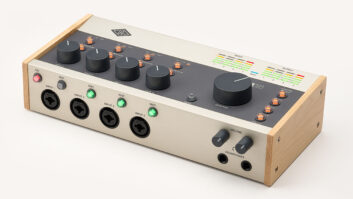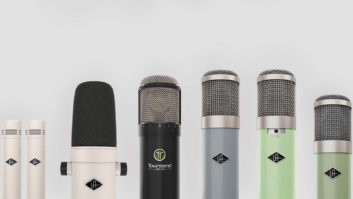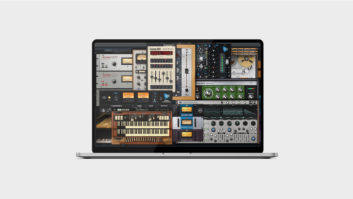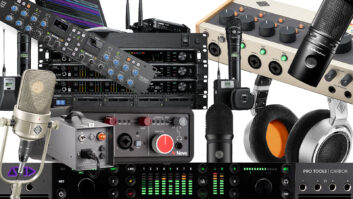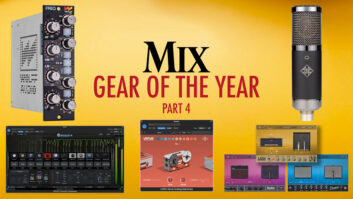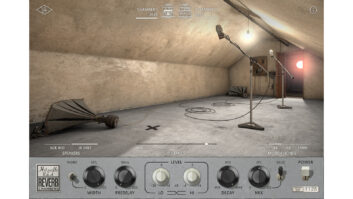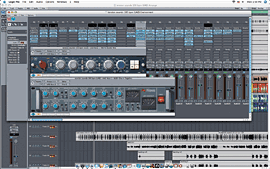
The UAD products let you effortlessly use massive, hardware-emulation plug-ins without taxing the host CPU. Here, the Neve 1081 EQ and 33609 limiter/compressor is running on a two-card system at 24-bit/48kHz with plenty of power to spare.
No matter how much heavy lifting the latest dual- and quad-core processors can handle, users of native DAW systems will always look for a way to add a few more plug-ins to the mix. With a host of included and optional software emulations of some of the world’s most coveted pieces of studio hardware, the UAD Series can help give your tracks a pro sound that will leave even the most well-trained listeners guessing. Available for PCI, PCI-X and PCI-E-equipped Mac and PCs, as well as ExpressCard laptops, UAD plug-ins work with VST, Audio Units and (with a special VST wrapper) RTAS host applications.
WALK THIS WAY
Engineers often think about selecting and tweaking reverb plug-ins, but they rarely look for interesting ways to automate them, which is too bad. Dreamverb — included with high-end UAD bundles — screams out for automation. This plug-in lets you morph between different room size/shapes, materials and air thicknesses — something useful in any number of ways. For film sound work, simply match your automation moves to camera pans or as characters move from one environment to the next. With all three of the parameters (room size/shape, material and air thickness) armed for automation, it will take a couple of passes to get it right, but once in place, the reverb will subtly change as it morphs in real time between two different environments.
A DANGEROUS PROPOSITION
Regardless of how DAW technology progresses, many producers and engineers yearn for that big console sound. And while a number of high-dollar outboard summing products are available, most of them require 16 discrete output channels and additional rackspace. However, several of the UAD plug-ins make it possible to achieve a similar sound without the hassle.
One quick approach is to stack the Neve 1081 SE and Neve 33609 plug-ins on your stereo bus and sweeten to taste. (If you’re using a multicard system, go ahead and use the full-strength Neve 1081.) You’ll immediately notice that your snares will pop with extra sizzle and that the entire mix takes on a more congealed, “glued-together” quality. (Many of UAD’s more CPU-intensive plug-ins include an SE version, which delivers most of the sound of the full version while devouring less horsepower.)
A second trick borrows more from the summing bus approach. Spread your tracks across your last eight stereo buses or condense your mix down to eight stereo stems, and simply drop in one Neve 1081 SE per bus or stem. (Again, if you’re using multiple cards and have the horsepower available, then go for the full 1081 plug-in.) From here, just make a few subtle EQ tweaks to infuse your mix with some of that classic British sound. The caveat here? This approach is best saved for your project’s mixing stage, as different DAWs handle plug-in delay compensation differently, and if you’re still laying down or overdubbing virtual instrument tracks, you could run into some latency issues.
DUPLICATE COMPRESSION ON DRUMS
With a collection of hardware emulation and high-end digital dynamics processors, the UAD plugs can do some very interesting things with your drum tracks. To add extra sizzle and sustain to your close-miked drum tracks, try a duplicate compression chain. Simply solo and bounce a copy of the track you want to process and add it back to your session on a separate track. Next, bring up the UAD 1176LN. The idea here is to remove as much dynamic range from the track as possible while adding some vintage grit. The result will be a longer sustain on the processed drum track that you can add back into the mix. You can also do this on groups of drum tracks to achieve a more unified sound.
DEEP FREEZE
Like standard VST and Audio Units plug-ins, UAD plug-ins can also be frozen (depending on your DAW), freeing the UAD hardware to take on other processing chores. The same care should be taken when freezing UAD plug-ins: Make sure that your right-boundary marker is pulled in close to the end of your arrangement or your computer will needlessly render 10 minutes of blank audio. Also, expect that this process will take a tad longer than standard native plug-ins because the processing is happening inside the UAD hardware instead of your computer’s CPU.
VIRTUAL HARDWARE CONSOLE
Some people just refuse to give up their aging computers, and UAD’s stock plug-ins offer an easy way to keep an older machine humming along. One simple way to maximize your available resources (and squeeze in another CPU-hogging virtual instrument) is to exclusively use the CS-1 channel strip plug-in for all of your EQ, dynamic, chorus/delay and basic reverb chores. The CS-1 adds a nice touch of hardware-inspired sound without sucking up a ton of CPU cycles. And to stretch things even further, you can disable unused EQ bands and audition each component of the CS-1 separately.
